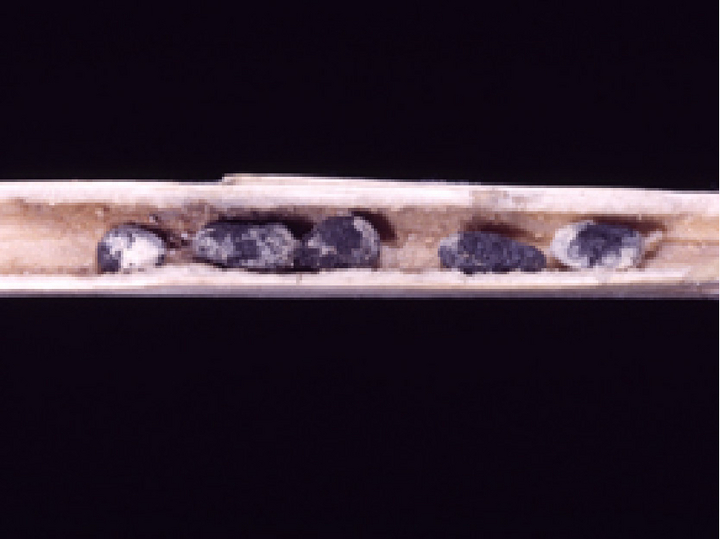Sclerotinia stem rot
Sclerotinia sclerotiorum
Damage symptoms

The first symptoms become visible around the time of flowering. Yellowing plants that quickly become distressed are conspicuous. On the stems of these plants, whitish-gray to light brown, stem-encompassing discolorations can be seen, which usually originate from the leaf axils. The interior of the stem beneath the discolored tissue is usually hollow. Stem breakage is often the result. If the stem is cut open lengthwise, black, up to 2 cm large and sometimes even larger fungal survival structures (= sclerotia) and a white, cotton-wool-like network of fungal threads (= mycelium) are found inside the stem. In high humidity or persistently wet weather, mycelium and the sclerotia appearing on it are also formed on the outside of the stem.
Propagation and transmission
Sclerotinia sclerotiorum forms 5 to 20 mm large and sometimes even larger sclerotia, with the help of which the fungus can survive in the soil, on infested plant remains or on perennial weeds. In the soil, the survival structures of the fungus can remain viable for up to ten years.
The sclerotia, which are located near the soil surface, begin to germinate in the spring. These germinate either directly with mycelium, which can penetrate into the plants via the roots or the root neck, or from the sclerotia grow one to a few centimeters large, stemmed and cup-shaped fruiting bodies (= apothecia) with spores (= ascospores) serving for reproduction. For the germination of the sclerotia, temperatures between 6 and 10 °C must prevail. Shading of the sclerotia and moist soil are optimal for their germination.
Ascospores are shed from the fruiting bodies and spread with the wind. These can infect plants through weakened tissue and/or wounds. Fallen petals caught in leaf forks and side shoot axils favor settlement of spores and their germination. Infections take place in cool and damp weather. The optimal temperature for fungal growth is 20°C, but the fungus can still grow at 0°C.
In addition to independent spread, the fungus can also be transmitted through the seed.
Prevention and control
- Use of healthy seeds
- No cultivation of rapeseed in wind-protected and humid locations
- Ensure the earliest possible harvest through timely cultivation
- Break up plant residues after harvesting and bag them to a depth of at least 10 cm
- Adherence to a minimum four-year (preferably six-year) crop rotation and pay attention to the susceptibility of previous crops. Cereals, corn, beets and potatoes are not susceptible or are less susceptible.
- Control weeds, as they are potential host plants.
- Possibly use plant protection products to control rapeseed canker (see list of plant protection products approved in Austria).
Last updated: 17.01.2022
automatically translated